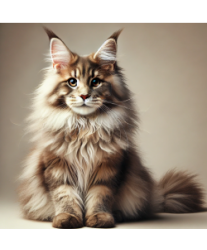


Testing itemsPolycystic kidney disease | Hypertrophic heart disease | Pyruvate kinase deficiency | Progressive retinal atrophy Test contentWhat is polycystic kidney disease?Polycystic kidney disease is a widespread genetic disease in cats that can cause kidney disease and progressive kidney failure. About 6% of cats worldwide suffer from polycystic kidney disease. Polycystic kidney disease is the presence of a defective gene that promotes the kidney's normal development and structural integrity. Cat genetic testing will provide invaluable insights into the risk of genetic diseases for your cat's health management in advance. What is hypertrophic heart disease?Hypertrophic cardiomyopathy is the most diagnosed cardiac disease in cats. The defect gene causes increased ventricular myocardium thickness. Therefore, cats are at risk of heart failure, thromboembolism, or occasional sudden death. Genetic testing for hypertrophic heart disease can help breeders identify the risk of genetic disease and make the proper matching selection based on the genetic conditions to reduce the risk of affected offspring. SuitablePolycystic kidney diseaseCat Breeds at High Risk: Persian, American Shorthair, Exotic ShorthairCat breeds with moderate risk: Asian, Bombay, Pomeranian, Snowshoe, Ragdoll, Birman, German Regal, Cornish Rex Hypertrophic heart diseaseMaine Coon, Ragdoll, Shorthair, or related breeds derived from these breeds Pyruvate Kinase Deficiency (PK Deficiency)Pyruvate kinase is an enzyme found in red blood cells. Pyruvate kinase deficiency is an inherited disorder when red blood cells break down faster than they should, resulting in a reduced number of red blood cells and anemia.Common breeds are more affected in Abyssinian and Somali breeds, as well as random-bred domestic shorthair cats. Many symptoms of Pyruvate kinase deficiency are from anemia with mild symptoms such as lethargy, weakness, and loss of appetite. Furthermore, also develop into acute anemia, which is life-threatening. Progressive retinal atrophy Progressive retinal atrophy is an inherited disease. It describes when the retina's photoreceptor cells (rods, cones) underdevelop or develop into retinal degeneration and atrophy. The cat's vision declines gradually, causing a risk of blindness. When the cat's vision is severely impaired, it may lose its direction or easily bump into objects. The prevalence often occurs in the Abyssinian and Somani breeds, with other influences such as Oxycat, American Curly, Bengal, etc.

Testing itemsPolycystic kidney disease | Hypertrophic heart disease Test contentWhat is polycystic kidney disease?Polycystic kidney disease is a widespread genetic disease in cats that can cause kidney disease and progressive kidney failure. About 6% of cats worldwide suffer from polycystic kidney disease. Polycystic kidney disease is the presence of a defective gene that promotes the kidney's normal development and structural integrity. Cat genetic testing will provide invaluable insights into the risk of genetic diseases for your cat's health management in advance. What is hypertrophic heart disease?Hypertrophic cardiomyopathy is the most diagnosed cardiac disease in cats. The defect gene causes increased ventricular myocardium thickness. Therefore, cats are at risk of heart failure, thromboembolism, or occasional sudden death. Genetic testing for hypertrophic heart disease can help breeders identify the risk of genetic disease and make the proper matching selection based on the genetic conditions to reduce the risk of affected offspring. SuitablePolycystic kidney diseaseCat Breeds at High Risk: Persian, American Shorthair, Exotic ShorthairCat breeds with moderate risk: Asian, Bombay, Pomeranian, Snowshoe, Ragdoll, Birman, German Regal, Cornish Rex ็็Hypertrophic heart diseaseMaine Coon, Ragdoll, Shorthair, or related breeds derived from these breeds

※此評估非臨床篩檢、診斷、治療及預後之基因檢測※評估項目脊髓性肌肉萎縮症| 多囊性腎病 | 肥厚型心臟病|丙酮酸激酶缺乏症 認識評估內容 脊髓性肌肉萎縮症緬因貓易患遺傳疾病—脊髓性肌肉萎縮症(SMA)。這種病症特徵是脊髓中的運動神經元退化,導致肌肉無力和萎縮。患有SMA的貓通常會出現跳躍困難、步態不穩和主要在後肢的肌肉萎縮等症狀。這種相關基因突變導致功能性運動神經元的喪失,從而削弱脊髓向肌肉傳遞信號的能力。對該特定突變的基因檢測可以幫助育種者和獸醫識別攜帶者和受影響的貓,從而做出明智的育種決策並及早干預以管理病情。 何謂多囊性腎病?多囊性腎病是很普遍的遺傳疾病,與一般貓咪產生腎衰竭的症狀類似而被忽略,因此在貓的族群中被傳播。此病會影響腎功能並導致腎衰竭, 而全世界罹患多囊性腎病的貓咪大約有6%左右。基因的缺陷會導致多囊性腎病的發生,此基因主要是促進腎臟的正常發育及結構完整。透過基因風險評估,您將會了解貓咪是否帶有遺傳疾病的風險,提早做好貓咪的健康管理。 何謂肥厚型心臟病肥厚型心臟病是貓咪最常見的心臟病。當基因產生缺陷時會導致心室心肌的厚度增加,貓咪就會有心臟衰竭、血栓栓塞或偶發性猝死等風險。肥厚型心臟病的基因風險評估可以幫助飼養者識別疾病好發的貓咪,並依據遺傳狀況做適當選擇的配對,降低後代受影響的風險。何謂丙酮酸激酶缺乏症(PK 缺乏症)丙酮酸激酶是在紅血球中發現的一種酶,如果缺乏這種酶,紅血球的壽命(存活時間)會顯著縮短,導致血液中的紅血球數量減少而有貧血狀況。常見品種在阿比西尼亞和索馬里品種以及隨機繁殖的家養短毛貓中較有患病的機率。而此症引起的貧血的病癥,例如嗜睡、虛弱、食慾不振,也可能發展為急性的貧血症危及生命。雖然 PK 缺乏症是遺傳性的,大部分貧血通常是輕微的臨床症狀。 適用對象多囊性腎病具有高度風險的貓品種: 波斯貓、美國短毛貓、異國短毛貓具有中度風險的貓品種: 亞洲貓、孟買貓、波密拉貓、雪鞋貓、布偶貓、伯曼貓、德文帝王貓、柯尼斯捲毛貓肥厚型心臟病緬因貓、布偶貓、短毛貓、或由這些品種衍生的相關貓種

Test itemsbrown gene | dilute geneTest Gene DescriptionThe brown gene controls the synthesis of eumelanin. Mutations in the brown gene may change the content of eumelanin and thus affect the appearance of coat color. Two mutation sites have been found on the brown gene to affect the appearance of coat color. The allele b corresponds to chocolate color , and the allele bl corresponds to cinnamon, the inheritance pattern is basically recessive, but B is dominant relative to b and b is dominant relative to bl (B > b > bl), so as long as there is one allele that is B coat color would be black, but with one allele b and one bl, it would be chocolate.The dilution gene is related to the transport of melanin bodies, so when the dilution gene mutations may cause the melanosomes to not be transported to their destinations correctly, resulting in uneven distribution of pigment in the hair, a mutation site has been found in the dilution gene that leads to lighter hair color , the genetic mode is recessive inheritance, that is, two alleles d at the same time will have the performance of dilution.Detection speciesBritish Shorthair, Ragdoll, Munchkin, British Longhair, Norwegian Forest, Russian Blue, Maine Coon, and others are also common.

張晉榮
先見基因 業務經理
觀看影片